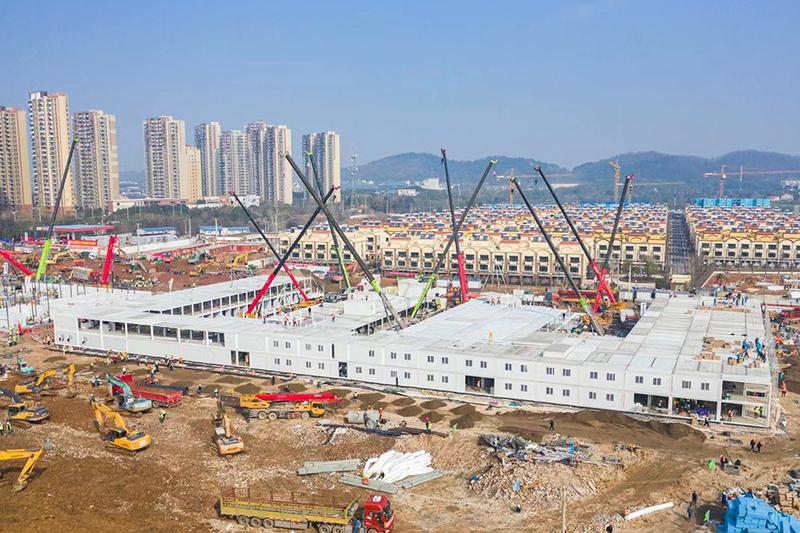 Huoshenshan Hospital takes shape in Wuhan, Hubei province, on Jan 30, 2020. (PHOTO / CHINA DAILY)
Huoshenshan Hospital takes shape in Wuhan, Hubei province, on Jan 30, 2020. (PHOTO / CHINA DAILY)
A livestream shows trucks, earthmoving equipment and building work in full swing at the construction site of two special hospitals in Wuhan, Hubei province, the epicenter of the novel coronavirus outbreak.
The footage illustrates how the two facilities are starting to take shape after just a few days of construction work.
The 1,000-bed Huoshenshan Hospital is scheduled to come into operation on Monday and the 1,500-bed Leishenshan facility will follow three days later
On Jan 24, the Wuhan government announced it would build a 1,000-bed infirmary, named Huoshenshan, or "Fire God Mountain", Hospital, to treat people diagnosed with the virus. The first building of the complex, which will eventually cover 25,000 square meters, was completed in just 16 hours.
 A man chats with a truck driver at Huoshenshan. (PHOTO / CHINA DAILY)
A man chats with a truck driver at Huoshenshan. (PHOTO / CHINA DAILY)
The city also announced construction of a 1,500-bed facility-Leishenshan, or "Thunder God Mountain", Hospital-to ease the shortage of beds for coronavirus patients.
Huoshenshan is scheduled to come into operation on Monday and Leishenshan will follow three days later.
IN PHOTOS: Construction of mobile hospital in Wuhan underway
As workers rushed to build the units at "Chinese speed", medical professionals and designers said they would ensure the facilities were safe and reliable, despite the race against time.
In 2003, as head of Beijing's Xiaotangshan Hospital, Zhang Yanling saw an emergency facility built from scratch in just seven days to help contain an outbreak of severe acute respiratory syndrome, or SARS, in the capital.
Last week, the 68-year-old traveled to Wuhan as an advisor on the construction of the two prefabricated hospitals.
"The new facilities have better designs and higher standards than Xiaotangshan Hospital," he told China National Radio.
"They will play a significant role in fighting the coronavirus," he said in the interview, adding that the new facilities will be professional hospitals for infectious diseases, rather than simply units to receive and quarantine patients. "They have to meet the highest standards."
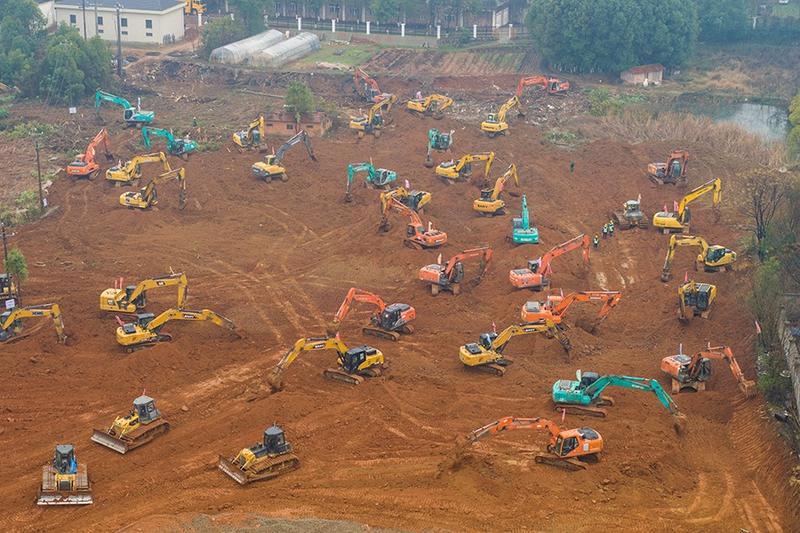 The construction site at Huoshenshan Hospital on Jan 24, 2020. (PHOTO / CHINA DAILY)
The construction site at Huoshenshan Hospital on Jan 24, 2020. (PHOTO / CHINA DAILY)
Peng Guanping, technical director of the sewage disposal systems for the new hospitals, said, "As the disease is highly infectious, our standards are even higher than usual."
He noted that while the normal time for sterilization of medical wastewater is 90 minutes, the new hospitals' disposal systems will allow five hours.
Those standards will not only apply to medical wastewater, as an impermeable membrane will ensure that even rainwater washing through the facilities will be treated.
"Every single drop of water discharged from the two hospitals will be sterilized to make sure it won't cause new infections," Peng said.
Having gained great experience of medical wastewater disposal during more than 10 years in the field, he said the Wuhan project is the biggest challenge of his career. That's because disposal systems on this scale normally take at least 60 days to complete, but this time the work will have to be finished within 10 days.
"As we are facing a totally new virus, we have to be careful and we have to come up with our best plan," he said.
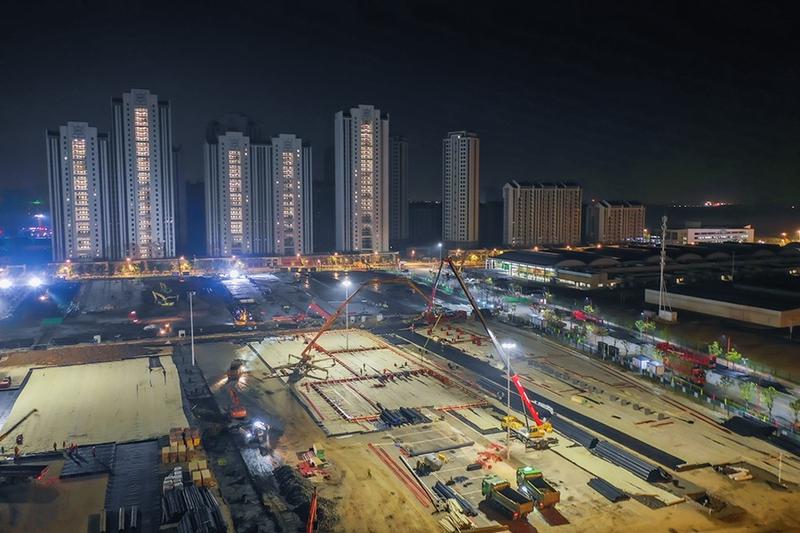 Work continues during the night at the construction site of Leishenshan Hospital in Wuhan, Hubei province, on Jan 29, 2020. (PHOTO / CHINA DAILY)
Work continues during the night at the construction site of Leishenshan Hospital in Wuhan, Hubei province, on Jan 29, 2020. (PHOTO / CHINA DAILY)
Special grant
The National Development and Reform Commission has allocated a special grant of 300 million yuan (US$43 million) for the two facilities, according to a notice posted on its website on Monday.
During a visit to the Huoshenshan Hospital site on Monday, Premier Li Keqiang-who is head of the leading group of the Communist Party of China Central Committee on prevention and control of the coronavirus-called for construction to be accelerated.
READ MORE: Premier Li arrives in Wuhan to guide epidemic control
Since the first case was reported late last year, the coronavirus has spread much faster than expected. On the Chinese mainland, the number of confirmed cases climbed from 571 to 11,791 from Jan 23 to Friday, meaning there are more coronavirus cases than there were SARS cases during the 2003 outbreak, which resulted in 774 deaths in 17 countries.
The technical drawings for the two new Wuhan hospitals were drawn up in just 60 hours by a team of 60 designers, including experts who worked on Xiaotangshan Hospital. Every piece of work in the project is counted in hours, not days.
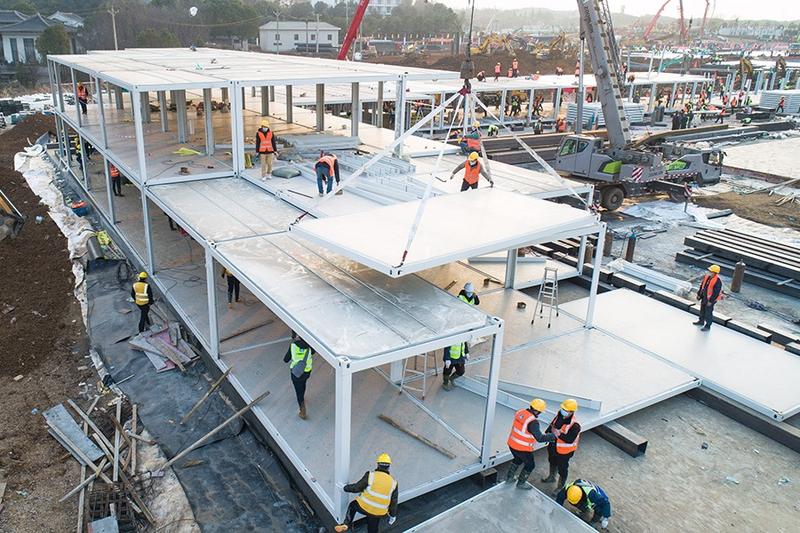 Workers erect a building for Huoshenshan Hospital in Wuhan, Hubei province, on Jan 28, 2020. (PHOTO / XINHUA)
Workers erect a building for Huoshenshan Hospital in Wuhan, Hubei province, on Jan 28, 2020. (PHOTO / XINHUA)
Xia Ping, general director of construction for both hospitals, said that despite the time constraints, every effort is being made to ensure construction quality.
"We have hundreds of quality inspectors to check every building frame, every welding point," Xia said.
Xiang Hui, director of construction at Leishenshan Hospital, said the facility has been designed to protect both the medical professionals who will work in it and local residents.
"It is a temporary emergency facility, but it has to meet the standards for a permanent hospital," Xiang said. "It can't be a source of infection."
He added that the builders are racing against time, but they are not neglecting crucial details, such as cleaning and sterilization work.
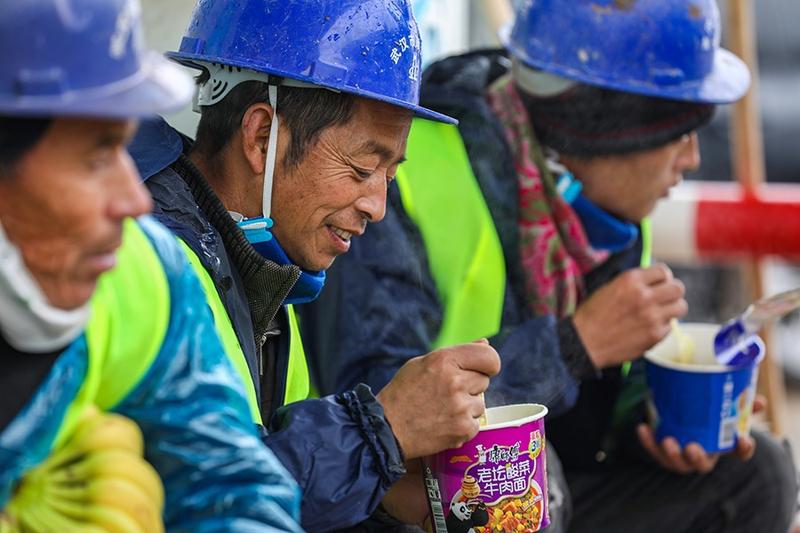 Workers eat instant noodles during a break at the construction site of Huoshenshan Hospital in Wuhan, Hubei province. (PHOTO / XINHUA)
Workers eat instant noodles during a break at the construction site of Huoshenshan Hospital in Wuhan, Hubei province. (PHOTO / XINHUA)
Two days after the launch of the Leishenshan project, 30 out of a projected 500 prefabricated buildings had arrived at the site from Suzhou in the eastern province of Jiangsu.
Chen Ye, one of the suppliers, said the remaining 470 buildings will be in place by Saturday.
"Time is life. We are racing against death," said Chen, who participated in rescue efforts after the 2008 Sichuan earthquake, which killed nearly 70,000 people. "But quality and safety are also important, as we are building medical facilities."
He said inpatient wards and intensive care units require extremely high standards of cleanliness and impermeability, and his factory in Suzhou is working around the clock to produce top-quality facilities. He has ordered 1,200 face masks to protect the company's 15 employees who are working at the construction site.
"We are assembling most of the buildings in our factory to shorten the workers' exposure time in Wuhan. It saves time and is safer for the workers," he said."Efficiency and safety are not contradictory."
Other projects
While Wuhan is scrambling to build new hospitals, authorities in three other cities-in the provinces of Hubei and Henan, and the Guangxi Zhuang autonomous region-have also begun constructing similar facilities to relieve pressure on the overwhelmed healthcare system.
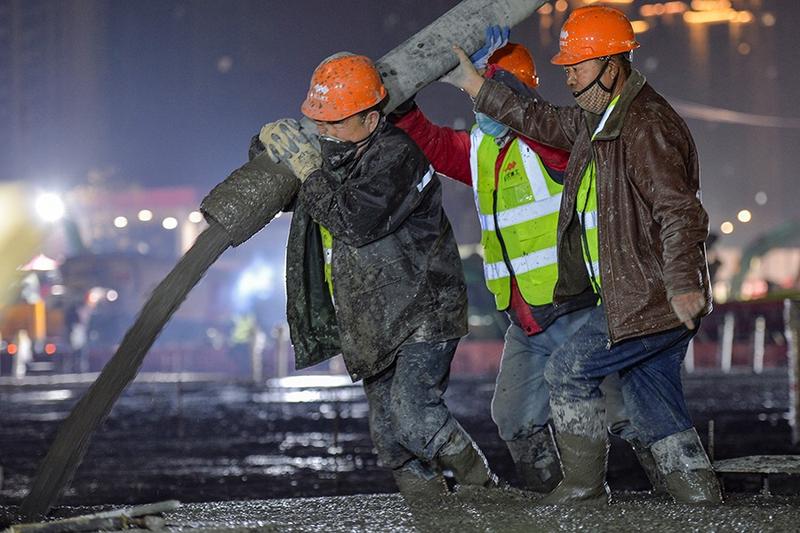 Workers pour cement at the construction site of Huoshenshan Hospital. (PHOTO / XINHUA)
Workers pour cement at the construction site of Huoshenshan Hospital. (PHOTO / XINHUA)
A makeshift hospital in Hubei's Huanggang, the city with the second-largest number of confirmed cases in the province, received its first patient on Tuesday night.
The medical center was originally planned as a new site for Huanggang Central Hospital, with the relocation process scheduled to be completed by May. Equipped with more than 1,000 beds, the center has been transformed into a temporary treatment facility for patients displaying symptoms of fever, according to Hubei Daily.
On Monday, construction of a quarantine facility began in Zhengzhou in Henan, a province that neighbors Hubei, and 28 prefabricated wards were in place by the next day.
The hospital has 287 designated beds, according to China Construction Seventh Engineering Division Corp, which noted that more than 1,200 workers have participated in the project.
As of midnight on Thursday, Henan had 352 confirmed coronavirus cases and two deaths had been reported, according to the provincial health commission.
Meanwhile, a hospital in Nanning, capital of Guangxi, is being transformed into a designated facility to receive patients with the coronavirus, according to local media. On Monday, the hospital stopped accepting new patients and transferred all non-coronavirus-related patients to other facilities.
The hospital manager told local media that two plans have been formulated to expand it into a 100-bed hospital: Plan A aims to transform it into a temporary facility within seven days, while Plan B will see the construction of a permanent center at a later date.
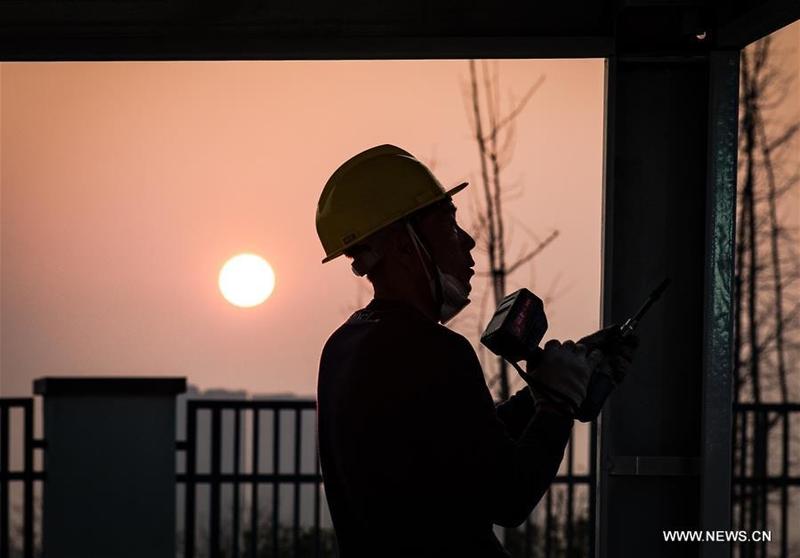 A worker at the construction site of Leishenshan Hospital in Wuhan, Hubei province, Jan 30, 2020. (PHOTO / XINHUA)
A worker at the construction site of Leishenshan Hospital in Wuhan, Hubei province, Jan 30, 2020. (PHOTO / XINHUA)
Echoes
The "makeshift hospital" strategy echoes the construction of Xiaotangshan Hospital in Beijing, which was built to accommodate patients displaying symptoms of SARS. On Thursday, Lei Haichao, director of the Beijing Municipal Health Commission, told Beijing News that renovation work had started at the hospital.
ALSO READ: Temperature screening in place at all subway stations in Beijing
"If necessary, we will use some of the beds to provide treatment for patients with the novel coronavirus,"Lei said.
Of all the new and upgraded facilities, though, Wuhan's Huoshenshan and Leishenshan hospitals are attracting the most attention, with tens of millions of people nationwide watching the construction process via livestreams from the site.
At 2:30 pm on Thursday, about 50 million people were watching the work, with the livestream providing a bird's-eye view of the site as workers, trucks and excavators raced to meet the deadline.
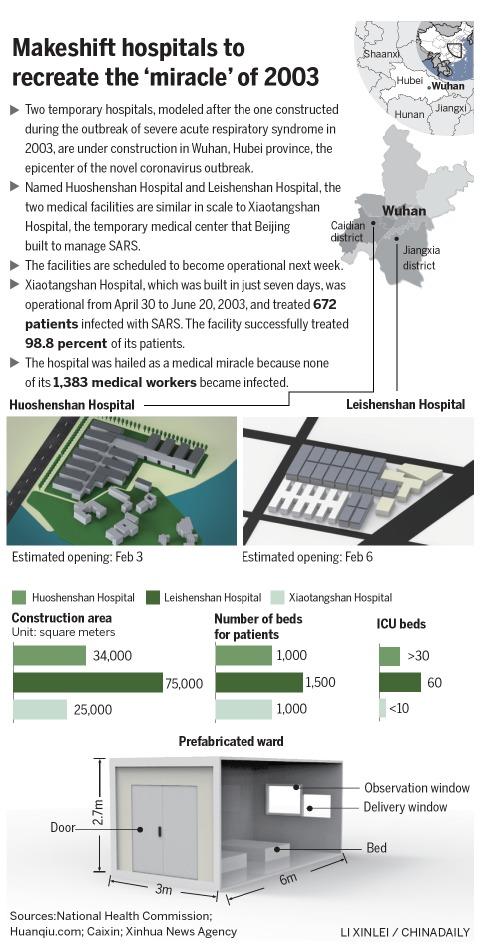
Many people who have stayed home to avoid possible infection have been following news of the virus via the internet. That has resulted in millions of "volunteer supervisors", as these netizens call themselves-they exchange their stories and feelings during this difficult time, in addition to discussing the construction project.
"I'm from Guangdong. I'm one of the online construction supervisors," wrote one netizen in a comment below the livestream. Another wrote,"Best wishes to the people of Wuhan, and good luck to all of us."
Peng, the wastewater disposal expert, was born and raised in Wuhan. He lives in the downtown with his parents, wife, 10-year-old son and 3-year-old daughter.
He has instructed his family not to leave the house, but he has been working at the construction site at least 12 hours a day for the past nine days.
He said he likes the names of the Huoshenshan and Leishenshan-"Fire God Mountain" and "Thunder God Mountain"-hospitals. In traditional Chinese culture, the fire god drives away plague, while the thunder god punishes demons.
"They are very appropriate names. They represent our virus-fighting spirit," he said. "Wuhan will definitely recover."


